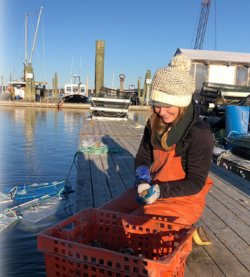There is no such thing as a “staycation” for the people working tirelessly to fish, farm, process, package, transport, and distribute seafood in the United States. Immediately deemed an “essential service,” the $244 billion/year seafood industry supports 1.74 million jobs and is the heart and soul of seaside towns across the United States—from quaint New England harbors to Gulf Coast communities to bustling ports in the Pacific Northwest and Alaska. When most people think of seafood and fishing, they picture rugged men donning bright-colored foul weather gear, bracing against waves or perhaps silently rowing a dory out into the fog—conjure the iconic Gorton’s Fisherman. However, as a proud owner of a seafood company in Maine and someone who works on the water, I personally see and rely on a diversity of individuals working onshore to get fish and shellfish from the sea to your table.
Commercial fishing involves more work than just fishing
In fact, more people work across the value chain and in fish processing than in commercial fishing itself. These critical roles are filled by predominantly female, minority, migrant and foreign-born workers. Globally, an estimated 80 to 90 percent of workers in seafood processing are women, and in the United States, 62.8 percent of people employed as “Butchers and Meat, Poultry, and Fish Processing Workers” are foreign-born. According to data analyzed by the Union of Concerned Scientists from the National Oceanic and Atmospheric Administration and Bureau of Labor Statistics Quarterly Census of Employment and Wages from the third quarter of 2019, there are 815 seafood processing plants in the United States in 294 counties employing tens of thousands of people nationwide.
My experience as a seafood harvester and company owner differs from those of equally important on-shore jobs in seafood processing. I set my own schedule and work outdoors, alone on a boat off an uninhabited island off the coast of Maine. I feel safe going to work and have access to the staples that so many of us take for granted (food, running water, stable housing, health care, etc.). Now contrast that to the experiences of workers in seafood processing during the COVID-19 outbreak. Work in seafood processing requires doing physically challenging work in close proximity for long hours indoors, and in the case of on-board ship processing and other seasonal fisheries, shared group housing and transportation.
Seafood processing workers are at increased risk for coronavirus infection
It doesn’t take a scientist or public health expert to recognize the heightened risk associated with these conditions, though both the CDC and many advocacy organizations, such as the Food Chain Workers Alliance and United Food and Commercial Workers Union, have issued guidance and urged additional protection for workers in processing plants. Worker and migrant justice organizations representing workers in seafood processing have been urgently and articulately expressing concerns and needs since the beginning of the outbreak. Despite these warnings, COVID-19 outbreaks have already been documented at seafood processing plants in Massachusetts, Maine, California, Oregon, Washington, and Alaska, and tragically, deaths have been linked to work in seafood processing plants.

Map shows number of seafood processing plants per county for Quarter 3 of 2019 (source: Bureau of Labor Statistics Quarterly Census of Employment and Wages available online at https://www.bls.gov/cew/ and number of reported cases of COVID-19 at seafood processing plants (source: Food and Environment Reporting Network available online at https://thefern.org/2020/04/mapping-covid-19-in-meat-and-food-processing-plants/). Credit: Rebecca Boehm, Economist, Union of Concerned Scientists.
We can keep these workers safe with evidence-based public health protections
While the experiences and needs of people working across the food chain vary and are best expressed first-hand, universal calls for basic health and safety protections include enhanced workplace safety, access to water and wash stations, personal protective equipment, access to COVID-19 testing and health care, paid sick days, and hazard pay. Beyond that, all workers across the food chain deserve access to critical social safety nets and resources, regardless of gender, race, ethnicity and immigration status. While demand for locally-harvested seafood has never been greater, support for those who process, pack, and ship our seafood is lagging. Make sure your Congressman supports the COVID-19 Every Worker Protection Act of 2020, which contains enforceable, science-based protections for workers in seafood processing plants, who often work long shifts in close proximity to each other.
Eat local fish, support your local fisher(wo)men, but please also consider supporting the numerous community-based worker’s justice and mutual aid groups in your community, who are proactively distributing food, testing, and personal protective equipment and performing key advocacy and legal services for workers in seafood, food processing, and agriculture. Learn more about the 5 things you can do to support food workers.

